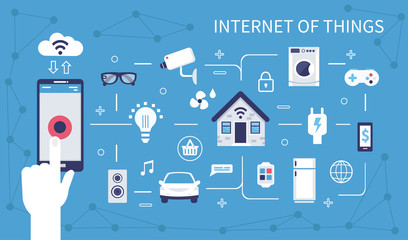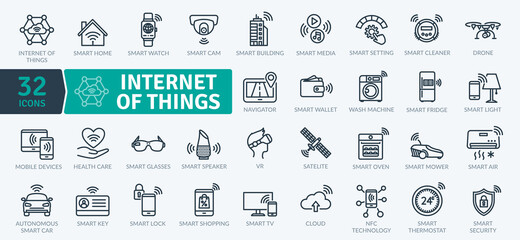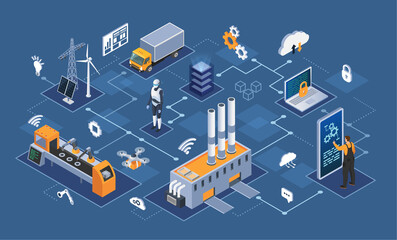The Internet of Things (IoT): Revolutionizing the Way We Live and Work
Introduction
The Internet of Things (IoT) refers to a growing network of connected devices, such as smartphones, wearables, home appliances, and industrial machines, that can communicate with each other and the internet. IoT enables the exchange of data and information between these devices, allowing for greater automation, improved efficiency, and enhanced connectivity in our daily lives and workplaces. The widespread adoption of IoT has the potential to revolutionize the way we live, work, and interact with technology.

List of some of the technologies that are driving the growth and development of the Internet of Things (IoT):
Sensors and Actuators: These devices are the building blocks of IoT, allowing devices to sense and respond to changes in the environment.
Wireless Connectivity: IoT devices rely on wireless connectivity technologies such as Wi-Fi, Bluetooth, and cellular networks to communicate with each other and the internet.
Cloud Computing: IoT devices generate and transmit vast amounts of data, which is often stored and processed in the cloud.
Big Data Analytics: The large amounts of data generated by IoT devices require advanced analytical tools and techniques to make sense of it.
Artificial Intelligence and Machine Learning: These technologies are being used to process and analyze the data generated by IoT devices, and to automate decision-making.
Edge Computing: This technology allows for data processing and decision-making to take place at the edge of the network, closer to the source of the data.
Security Technologies: IoT devices and networks are vulnerable to cyber attacks, making it essential to implement robust security technologies to protect them.
Low-Power Wide-Area Networks (LPWANs): These networks are designed to support low-power, long-range IoT devices, making it possible to deploy IoT networks in remote and rural areas.
Blockchains: These distributed ledger technologies can be used to secure and validate transactions between IoT devices, providing an additional layer of security for IoT networks.
5G Networks: The next generation of mobile networks is expected to play a key role in enabling the growth of IoT, providing faster and more reliable connectivity for IoT devices.
Tools required for IOT
IoT Platforms: IoT platforms are cloud-based services that provide a range of services and tools for building, deploying, and managing IoT solutions. Examples include Amazon Web Services IoT, Microsoft Azure IoT, and Google Cloud IoT.
Sensors and Actuators: Sensors and actuators are the physical components of an IoT system that sense the environment and interact with it. Examples include temperature sensors, humidity sensors, and smart switches.
Wireless Connectivity: IoT devices rely on wireless connectivity to communicate with the cloud and with each other. Examples of wireless technologies include Wi-Fi, Zigbee, and cellular.
Cloud Computing: IoT solutions rely on cloud computing to store and process the vast amounts of data generated by IoT devices. Examples of cloud platforms include Amazon Web Services, Microsoft Azure, and Google Cloud.
Data Analytics Tools: IoT solutions generate vast amounts of data, and data analytics tools are used to process and analyze this data to extract insights and drive business decisions. Examples of data analytics tools include Apache Spark, Apache Storm, and Tableau.
Security Tools: IoT solutions require robust security to protect against cyber threats and to ensure the privacy of data. Examples of security tools include encryption, firewalls, and identity and access management systems.
Development Tools: IoT solutions require a range of development tools to build, test, and deploy IoT solutions. Examples of development tools include Raspberry Pi, Arduino, and the Node-RED visual programming tool.

Roleplay of Microsoft Azure in IOT
Microsoft Azure is a cloud computing platform that plays a significant role in the Internet of Things (IoT). Azure provides a range of services and tools that enable organizations to build, deploy, and manage IoT solutions. Some of the ways in which Azure is involved in IoT include:
IoT Hub: This is a fully managed service that provides bi-directional communication between IoT devices and the cloud.
IoT Edge: This service allows for the deployment of cloud intelligence to the edge of the network, making it possible to process data closer to the source of the data.
Azure Stream Analytics: This service provides real-time data processing and analysis for IoT solutions, allowing for the creation of real-time insights and actions.
Time Series Insights: This service provides a fast and powerful way to store, analyze, and visualize time-stamped data, making it ideal for IoT solutions that generate large amounts of time-series data.
Azure Digital Twins: This service provides a platform for creating digital representations of physical spaces, such as buildings and factories, allowing for the simulation of real-world scenarios and the creation of smart environments.
Azure Maps: This is a mapping and location-based service that can be used in IoT solutions to provide location-based insights and to enable location-based services.
Azure Sphere: This is a secure IoT platform that provides a complete solution for building and managing secure IoT devices.
Career Path of IOT
IoT Engineer: IoT engineers are responsible for designing, building, and testing IoT devices and networks. They work with a range of technologies, including sensors, actuators, wireless connectivity, and cloud computing.
IoT Data Scientist: IoT data scientists use data analytics techniques to process and analyze the vast amounts of data generated by IoT devices. They work with big data tools and technologies to create real-time insights and drive business decisions.
IoT Solutions Architect: IoT solutions architects are responsible for designing and deploying IoT solutions that meet the needs of businesses and organizations. They work with a range of stakeholders to understand their requirements and to design and implement the best solution.
IoT Security Specialist: IoT security specialists are responsible for ensuring the security of IoT devices and networks. They work with security technologies such as encryption, authentication, and firewalls to secure IoT systems and protect against cyber threats.
IoT Project Manager: IoT project managers are responsible for leading teams of engineers, designers, and data scientists to develop and deploy IoT solutions. They work with stakeholders to define project requirements, manage budgets and schedules, and ensure that projects are delivered on time and within budget.
IoT Business Analyst: IoT business analysts work with organizations to understand their IoT requirements and to design and implement IoT solutions that drive business value. They work with stakeholders to understand the business problem and to design and implement a solution that meets their needs.

Realtime Project of IOT
Smart Homes: A smart home is a home that is equipped with IoT devices that allow you to control and monitor various aspects of your home from a single app. Examples of smart home devices include smart locks, smart lights, and smart thermostats.
Predictive Maintenance: Predictive maintenance is an IoT-based solution that uses data from sensors and machine learning algorithms to predict when a machine is likely to fail. This allows organizations to schedule maintenance before a machine fails, reducing downtime and increasing efficiency.
Agricultural Monitoring: Agricultural monitoring is an IoT-based solution that uses sensors and other technologies to monitor crops, soil moisture, and weather conditions. This allows farmers to optimize crop yields and reduce waste.
Environmental Monitoring: Environmental monitoring is an IoT-based solution that uses sensors and other technologies to monitor air and water quality, weather conditions, and wildlife populations. This allows organizations to take action to protect the environment and prevent pollution.
Asset Tracking: Asset tracking is an IoT-based solution that uses GPS and other technologies to track the location of vehicles, containers, and other assets in real time. This allows organizations to optimize their supply chain and reduce waste.
Health Monitoring: Health monitoring is an IoT-based solution that uses sensors and other technologies to monitor a person's health and wellness. This allows individuals to track their health and wellness, and to take action to improve their health.

How Robots are Involved In IOT
Robots play a key role in the Internet of Things (IoT) by providing the physical interface between IoT devices and the real world. Some of the ways that robots are involved in IoT include:
Industrial Robots: Industrial robots are used in manufacturing and other industries to automate repetitive and dangerous tasks. These robots are equipped with sensors and other IoT devices that allow them to communicate with the cloud and with other robots in real time.
Service Robots: Service robots are used in retail, healthcare, and other industries to assist humans. These robots are equipped with sensors, cameras, and other IoT devices that allow them to interact with their environment and with humans in real time.
Autonomous Robots: Autonomous robots are robots that are capable of making decisions and performing tasks without human intervention. These robots are equipped with sensors, cameras, and other IoT devices that allow them to navigate and interact with their environment in real time.
Drones: Drones are unmanned aerial vehicles that are used for a wide range of applications, including delivery, inspection, and surveillance. Drones are equipped with sensors, cameras, and other IoT devices that allow them to collect and transmit data in real time.
Smart Robots: Smart robots are robots that are equipped with artificial intelligence and machine learning algorithms. These robots use IoT data to learn and make decisions, and they are capable of performing complex tasks that would be difficult or impossible for humans to perform.
"The Internet of Things is transforming the world in ways we never imagined." - Bill Gates
"The Internet of Things is not just about technology, it's about people and the way they live their lives." - Ginni Rometty

